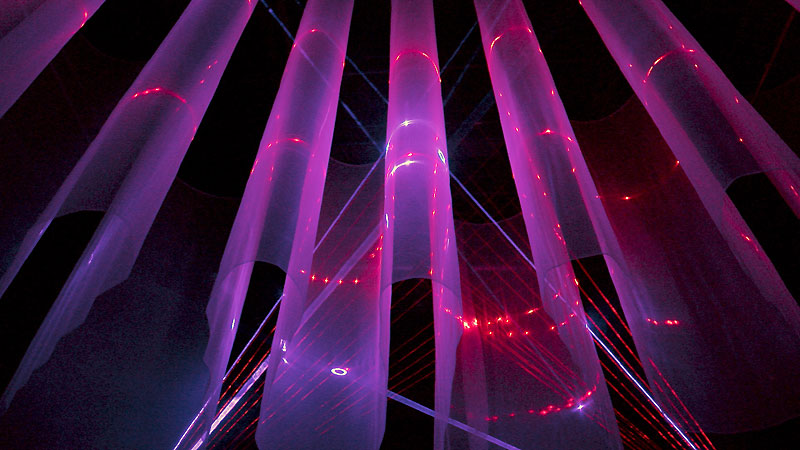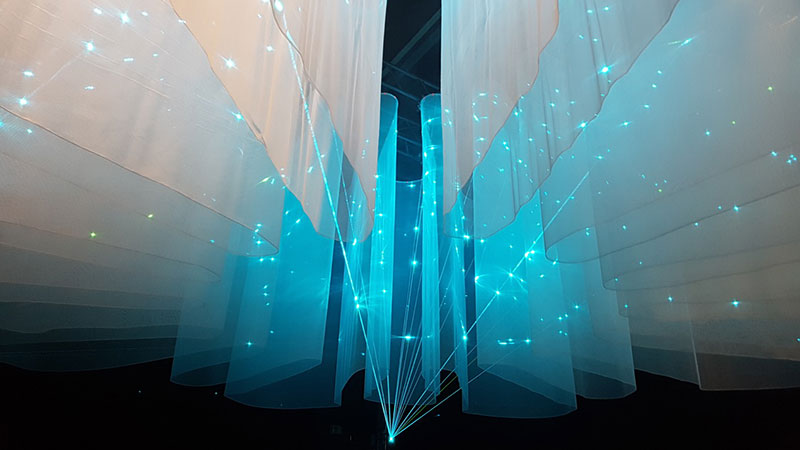Robert Henke in his post-Ableton life has continued to see his stock rise on the media art scene.
But in some ways, that’s a funny thing. You’ll very often see Robert in one of two guises – as club act, or large-scale AV event. Yet the very thing that makes his style so distinctive is somehow the opposite of what you normally expect from those arenas. Robert’s approach is meticulous, detail-oriented, compulsive. In some sense, I think that’s what makes it scale. Rather than crank the volume, push emotions, and embrace spectacle (in the AV/concert) and the visceral (in the club), what you get is the surgically precise, artful use of those settings.
Now, it’s just my own personal taste, but I find that I can relate to Robert’s work emotionally most in the smaller scale works – the ones at the margins, the gallery performance, the sketch. These are the miniatures to the full-canvas, big budget numbers.
“Spline” isn’t physically small, but it is one of these marginalia in comparison to the flagship Lumiere. And talk about scaling: it’s hypnotic to watch even just in this short video.
It may add the element those lasers were missing, in all their precision – some organic rough edges. A trip into Spline promises to feel like a field trip to an alien aquarium.
Have a watch/listen:
Details:
120 meters of thin fabric are suspended from the ceiling to form a curved curtain. Four lasers in the corners of the room each project sixteen sharp beams of light onto it. The curtain’s shape has been calculated using the mathematical principle of spline interpolation. By tracing the surface with the laser beams, a complex geometric figure of 64 intersecting lines emerges, built of light and fog. Movements are synchronised with sonic events. Sound and lasers are controlled in realtime by an algorithmic process, creating an infinite number of variations over the course of the exhibition period.
This week also coincides with news about another titan of German media art, Carsten Nicolai, who has again separated his brand/label (Noton) from what had been raster-noton. But it’s worth saying that Robert is a unicorn in this scene, essentially a one-man studio all his own, aided by an assistant or two and joining in collaborations (as with Christopher Bauder), but insisting on writing his own code and getting involved in every element of engineering. That’s not a criticism of Carsten – on the contrary, a solo alva noto show is a great example of his own ability to jam in any setting. But since there is limited room in the world to start something like Noton, it’s worth considering that even Robert Henke’s biggest works still have his literal fingerprints on them, not just his aesthetic ones.
And that part gives me hope. The honest truth is, an emerging media artist simply isn’t going to have access to big resources. The whole medium is actually doomed if we assume the biggest budget and the greatest technical wizardry and the largest scale always wins.
But instead of looking to that as the model, an up-and-coming artist might look at the fact that a Robert Henke piece can be self-coded. It could use, in place of those fancy lasers, projection and still work compositionally. It could be as effective on a 2-meter wall as in a big venue.
And so long as we appreciate those elements of the medium, anyone can be a star.


And from these smaller sketches, Robert continues to build the flagship into a magnum opus, each a new version – the laser AV equivalent of Beethoven’s iterative overtures.
The best way to see the state-of-the-art evolution there will be through an event for which CDM is media partner, along with our friends at CTM Festival. (Like-minded, like-acronymed, we.)

Lumiere II.
Is artistic refactoring a thing? It is now. Here’s Robert on the process that has led to Lumiere III, the latest version we witness:
The desire to create a third iteration came not so much from a perceived problem with the second one, but rather from an abundance of new ideas created during the performances and also from the urge to update the graphics software in such a way that it also could drive upcoming laser installations. The Fall installation presented in 2016 already made use of the new software, and the Spline installation in March 2017 will also rely on it, but requires again a detail improvement which has not been integrated yet. That technical aspect is essential as it provides the means to create both more complex concert works and more complex installations without the necessity to reinvent the wheel each time again. A desired goal for Lumière III was also to focus more on sound design. The sound engine got a major update therefore, too.
The complete software package that is now driving Lumière, both visually and for the sound became so complex that writing documentation about it became an essential part of the work. Lumière III will probably get some minor updates and changes after the initial series of performances and is planned to tour for 2017 – 2018.
Read up on the whole history on Robert’s site:
And if you’re in Berlin, Technosphärenklänge #3 arrives on Friday the 12th of May, to the Haus der Kulturen der Welt. We’ll be bringing you more on the other partners in this event, as well.